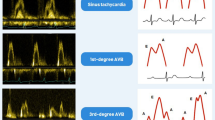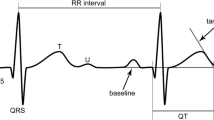Summary
Atrial premature beats are frequently diagnosed during pregnancy (PR), supraventricular tachycardia (SVT; atrial tachycardia, AV nodal reentrant tachycardia, circus movement tachycardia) less frequently. For acute therapy, electrical cardioversion with 50 – 100 J is indicated in all unstable patients (pts). In stable SVT the initial therapy includes the vagal maneuver to terminate breakthrough tachycardias. For short-term management, when the vagal maneuver fails, intravenous adenosine is the first-choice drug and may safely terminate the arrhythmia. For long-term therapy, β-blocking agents with β1 selectivity are first-line drugs; class Ic agents or the class III drug sotalol (sot) are effective and therapeutic alternatives. Ventricular premature beats are also frequently present during PR and benign in most pts; however, malignant ventricular tachyarrhythmias (sustained ventricular tachycardia [VT], ventricular flutter [VFlut], ventricular fibrillation [VF]) were observed less frequently. Electrical cardioversion is necessary in all pts with a hemodynamically unstable situation and life-threatening ventricular tachyarrhythmias; in hemodynamically stable pts, initial therapy with ajmaline, procainamide or lidocaine is indicated. If prophylactic therapy is needed, β-blocking agents with β1 selectivity are considered as first-choice drugs. If this therapy is ineffective, class Ic agents or sot can be considered. In pts with syncopal VT, VF, VFlut or aborted sudden death an implantable cardioverter-defibrillator is indicated. In pts with symptomatic bradycardia, a pacemaker can be implanted using echocardiography at any stage of PR. The treatment of the pregnant patient with cardiac arrhythmias requires important modification of the standard practice of arrhythmia management. The goal of therapy is to protect the patient and fetus through delivery, after which chronic or definitive therapy can be administered.
Zusammenfassung
Supraventrikuläre Extrasystolen werden während einer Schwangerschaft (SWS) häufig beobachtet, supraventrikuläre Tachykardien (atriale Tachykardien, AV-Knoten-Reentry-Tachykardien, Circus-movement-Tachykardien) dagegen eher seltener. Zur Akuttherapie (AT) ist bei hämodynamischer Instabilität (HI) eine elektrische Kardioversion (KV) mit 50 – 100 Joules notwendig. Bei stabiler Hämodynamik (SH) sollten primär vagale Manöver durchgeführt werden, bei Versagen vagaler Maßnahmen ist Adenosin das Medikament der 1. Wahl. Für die Langzeittherapie (LZT) kommen vor allem β1-selektive Betablocker (BB) in Frage, seltener spezifische Antiarrhythmika (AA) der Klassen Ic oder der Klasse III (Sotalol [Sot]). Ventrikuläre Extrasystolen sind während einer SWS ebenfalls relativ häufig und bei den meisten Patientinnen (Pt) harmlos, maligne ventrikuläre Arrhythmien (ventrikuläre Tachykardien KT, Kammerflattern KFlat, Kammerflimmern KF) werden dagegen eher selten beobachtet. Als AT sollte bei HI eine elektrische KV erfolgen, bei SH kommen Ajmalin, Procainamid oder Lidocain in Betracht. Für die LZT sollten primär β1-selektive BB eingesetzt werden, bei Therapierefraktärität kommen spezifische AA der Klasse Ic oder Sot in Betracht. Für Pt mit synkopaler KT, KF, KFlat oder überlebtem plötzlichen Tod ist der implantierbare Defibrillator eine therapeutische Alternative. Bei Pt mit symptomatischen Bradykardien kann unter Echokontrolle ein Schrittmachersystem in jedem Stadium der SWS implantiert werden. Trotz notwendiger Besonderheiten im therapeutischen Verhalten während einer SWS können alle supraventrikulären und/ oder ventrikulären Arrhythmien adäquat behandelt werden, und bei sorgfältiger Beachtung von Risiken, Nebenwirkungen und Komplikationen aller therapeutischen Maßnahmen können auch komplizierte Schwangerschaften erfolgreich beendet werden.
Similar content being viewed by others
Author information
Authors and Affiliations
Rights and permissions
About this article
Cite this article
Trappe, HJ., Pfitzner, P. Herzrhythmusstörungen während der Schwangerschaft. Z Kardiol 90 (Suppl 4), IV36–IV44 (2001). https://doi.org/10.1007/s003920170026
Published:
Issue Date:
DOI: https://doi.org/10.1007/s003920170026




